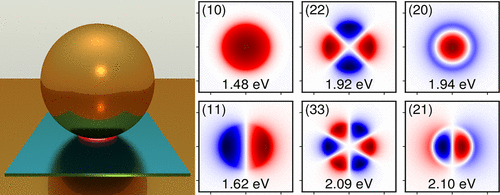当前位置:
X-MOL 学术
›
ACS Photonics
›
论文详情
Our official English website, www.x-mol.net, welcomes your feedback! (Note: you will need to create a separate account there.)
Plasmonic Nanocavity Modes: From Near-Field to Far-Field Radiation
ACS Photonics ( IF 7 ) Pub Date : 2020-01-21 , DOI: 10.1021/acsphotonics.9b01445 Nuttawut Kongsuwan 1, 2 , Angela Demetriadou 3 , Matthew Horton 4 , Rohit Chikkaraddy 4 , Jeremy J. Baumberg 4 , Ortwin Hess 1, 5
ACS Photonics ( IF 7 ) Pub Date : 2020-01-21 , DOI: 10.1021/acsphotonics.9b01445 Nuttawut Kongsuwan 1, 2 , Angela Demetriadou 3 , Matthew Horton 4 , Rohit Chikkaraddy 4 , Jeremy J. Baumberg 4 , Ortwin Hess 1, 5
Affiliation

|
In the past decade, advances in nanotechnology have led to the development of plasmonic nanocavities that facilitate light–matter strong coupling in ambient conditions. The most robust example is the nanoparticle-on-mirror (NPoM) structure whose geometry is controlled with subnanometer precision. The excited plasmons in such nanocavities are extremely sensitive to the exact morphology of the nanocavity, giving rise to unexpected optical behaviors. So far, most theoretical and experimental studies on such nanocavities have been based solely on their scattering and absorption properties. However, these methods do not provide a complete optical description of the nanocavities. Here, the NPoM is treated as an open nonconservative system supporting a set of photonic quasinormal modes (QNMs). By investigating the morphology-dependent optical properties of nanocavities, we propose a simple yet comprehensive nomenclature based on spherical harmonics and report spectrally overlapping bright and dark nanogap eigenmodes. The near-field and far-field optical properties of NPoMs are explored and reveal intricate multimodal interactions.
中文翻译:

等离子体纳米腔模式:从近场到远场辐射
在过去的十年中,纳米技术的进步导致了等离子体纳米腔的发展,该等离子体腔在环境条件下促进了光-物质的强耦合。最可靠的示例是镜面纳米颗粒(NPoM)结构,其几何形状可通过亚纳米精度进行控制。在这样的纳米腔中激发的等离子体激元对纳米腔的确切形态极为敏感,从而引起了意外的光学行为。迄今为止,关于这种纳米腔的大多数理论和实验研究仅基于它们的散射和吸收特性。但是,这些方法不能提供纳米腔的完整光学描述。在这里,NPoM被视为支持一组光子准正态模式(QNM)的开放非保守系统。通过研究纳米腔的形态学相关的光学特性,我们提出了一种基于球谐函数的简单而全面的命名法,并报告了光谱重叠的明暗纳米本征模式。探索了NPoM的近场和远场光学特性,揭示了复杂的多峰相互作用。
更新日期:2020-01-22
中文翻译:

等离子体纳米腔模式:从近场到远场辐射
在过去的十年中,纳米技术的进步导致了等离子体纳米腔的发展,该等离子体腔在环境条件下促进了光-物质的强耦合。最可靠的示例是镜面纳米颗粒(NPoM)结构,其几何形状可通过亚纳米精度进行控制。在这样的纳米腔中激发的等离子体激元对纳米腔的确切形态极为敏感,从而引起了意外的光学行为。迄今为止,关于这种纳米腔的大多数理论和实验研究仅基于它们的散射和吸收特性。但是,这些方法不能提供纳米腔的完整光学描述。在这里,NPoM被视为支持一组光子准正态模式(QNM)的开放非保守系统。通过研究纳米腔的形态学相关的光学特性,我们提出了一种基于球谐函数的简单而全面的命名法,并报告了光谱重叠的明暗纳米本征模式。探索了NPoM的近场和远场光学特性,揭示了复杂的多峰相互作用。



























 京公网安备 11010802027423号
京公网安备 11010802027423号